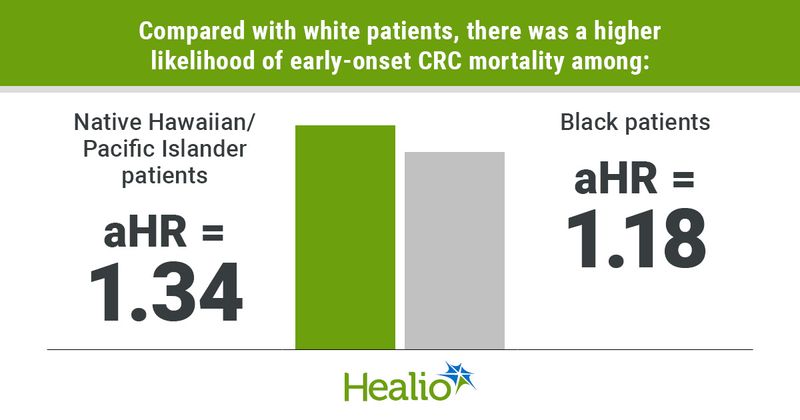‘Clear survival disparities’ in early-onset CRC for Black, Pacific Islander patients
Key takeaways:
- Early-onset CRC mortality risk was higher for Black, Native Hawaiian and Pacific Islander patients.
- Disparities were reduced when neighborhood socioeconomic and insurance statuses were included.
Black and Native Hawaiian or other Pacific Islander patients with early-onset colorectal cancer had higher risk for mortality compared with white patients, with data supporting the role of social determinants of health in those differences.
“Although published data has pointed to the rise in incidence of early-onset CRC among several racial and ethnic groups, our results indicate that there are clear survival disparities, particularly among Black and Native Hawaiian or other Pacific Islander patients,” Maria Elena Martinez, PhD, MPH, professor in the department of family and preventive medicine at the Herbert Wertheim School of Public Health and Human Longevity Science at UC San Diego, told Healio.

To investigate the racial and ethnic differences related to survival among patients with early-onset CRC, as well as drivers of these differences, Martinez and colleagues used the California Cancer Registry to identify patients aged 18 to 49 years diagnosed between January 2000 and December 2019.
Of 22,834 patients (53.5% men; median age, 44 years) identified, racial and ethnic identities included non-Hispanic white (45.9%), Hispanic (30.2%), Asian American (15.5%), non-Hispanic Black (7.3%), Native Hawaiian or other Pacific Islander (0.6%) and non-Hispanic American Indian or Alaska Native (0.5%). The researchers further disaggregated Asian American patients into seven subgroups. The median follow-up was 4.2 years.
According to results published in JAMA Network Open, a higher likelihood of early-onset CRC mortality was observed for Native Hawaiian or other Pacific Islander patients (adjusted HR [aHR] = 1.34; 95% CI, 1.01-1.76) and Black patients (aHR = 1.18; 95% CI, 1.07-1.29) compared with white patients. Among Asian American patients, those of Southeast Asian descent had a higher mortality risk (aHR = 1.29; 95% CI, 1.13-1.46).
In a base model adjusted for age, sex and tumor characteristics, Hispanic patients also were at greater risk for mortality (aHR = 1.15; 95% CI, 1.08-1.22), although the correlation was no longer present after adding neighborhood socioeconomic status to the model (aHR = 1; 95% CI, 0.94-1.06).
Likewise, a slight reduction in mortality risk was observed among Native Hawaiian or other Pacific Islander patients after adding neighborhood socioeconomic status (aHR = 1.42; 95% CI, 1.07-1.87 vs. aHR = 1.34; 95% CI, 1.03-1.76), as well as among Black patients (aHR = 1.43; 95% CI, 1.3-1.56 vs. aHR = 1.27; 95% CI, 1.16-1.4).
Further, the high mortality risk initially observed among Southeast Asian patients in the base model was no longer present after adjusting for insurance status (aHR = 1.17; 95% CI, 1.03-1.34 vs. aHR = 1.1; 95% CI, 0.96-1.25).
“Differences in racial and ethnic early-onset CRC mortality point to the important role of social determinants of health in driving these disparities and the need to address these in order to ensure equity in early-onset CRC survival,” Martinez said, noting that the disaggregation of racial and ethnic groups also provides important information to personalize care.
“This could include assessing social factors at the time of diagnosis and treatment and tailoring interventions to address these,” she added. “It is also important to ensure that these high-risk patients receive information and care in a culturally appropriate manner and in their preferred language.”
